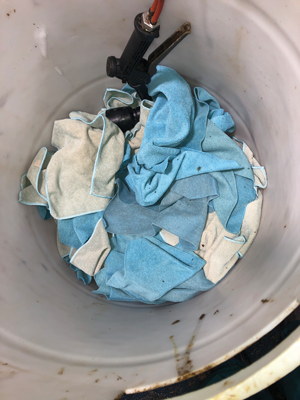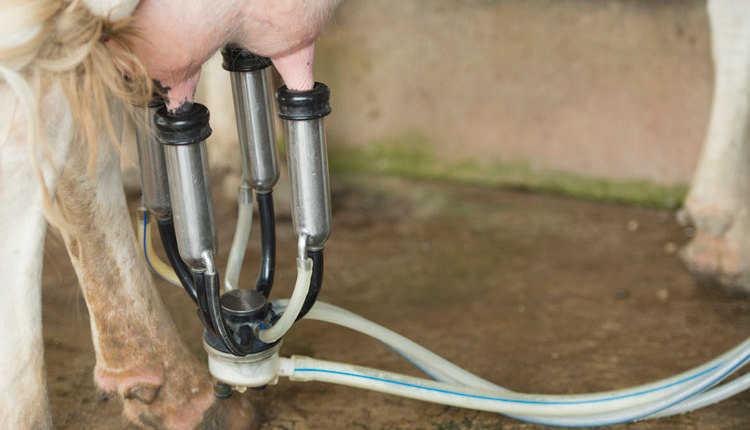The authors are with Quality Milk Production Services at Cornell University’s College of Veterinary Medicine.
Controlling mastitis and producing high-quality milk are only realized when teats are clean and dry prior to milking. In order to achieve clean teat ends, many farms use cloth or microfiber towels to give their milkers a good tool to obtain success.
At Cornell University’s Quality Milk Production Services (QMPS), we have been a proponent of these towels and have seen many farms achieve excellent results. Unfortunately, we have also seen farms that have had challenges with towels, mainly due to how they are laundered. In this article, we will outline a few of these farms in the hopes that it will prevent a similar situation from happening on your farm.

The towels weren’t clean
A 2,150-cow dairy was experiencing issues with Staph. aureus, so we wanted to check the microfiber towels to make sure that there was not Staph. aureus present on the clean towels.
Towels were washed in hot water with detergent and completely dried. During our farm visit, it was observed that the washing machine was being overloaded.
A towel was collected from the dryer and analyzed for bacteriological results. The total bacteria count of the towel taken out of the dryer was 74,300 colony forming units (CFU) per square centimeter (cm²). On a good note, there was no Staph. aureus identified on the clean towel.
Next, we went to the parlor and took a towel out of the towel bin and had this towel analyzed for bacteriological results. The clean towel in the parlor had a bacteria count of 522,000 cfu/cm². Streptococcus organisms represented a large portion of the bacteria count on the towel, and Streptococcus organisms were the main cause of mastitis on this farm.
Clean towels were kept in a 55-gallon drum in the parlor. After a discussion with the farmer, we made dirty towel bins that, when full, lead to the washing machine not being overloaded. A smaller diameter barrel is used for clean towels in the parlor.
A follow-up bacteriological test found 100 cfu/ml of bacteria on a clean towel. The ability of a washing machine to provide clean towels is directly related to not overloading it.
The towels weren’t dry
Evaluation of an 800-cow dairy with an elevated somatic cell count (SCC) identified approximately 200 cows (25% of the herd) infected with the contagious mastitis pathogen Prototheca. In an effort to identify a source of Prototheca mastitis and any contributing risk factors, environmental cultures were performed throughout the farm and milking parlor. This included swabs of inflations, teat dip cultures, and laundered microfiber towels.
The towels were laundered with a powdered detergent and a bleach product. Towels were spun dry in a front-loading, commercial washing machine. They were not fully dried in a dryer.
Towel cultures revealed organic matter (wood shavings for bedding and manure) and Prototheca present on the laundered towels used during milking. The situation was resolved by grouping all Prototheca-infected cows together and culling them over time. The farm owners also trained staff to not overfill the washing machine and installed a commercial dryer to completely dry towels.
Additions were needed
A 300-cow dairy that we work with had been struggling to control the SCC of their bulk tank milk. We cultured all the cows and found that 18% were infected with Prototheca.
These cows were moved into a separate group and milked last as Prototheca is known to spread from cow to cow. Many of these cows were culled over the next six months, but SCC did not improve. We cultured the entire herd again and found even more cows infected with Prototheca. In a discussion on the farm, it was decided to culture a towel. When the results came back on three different towels, they were all greater than 6 million cfu/cm²! The farm was not drying their towels but was using hot water and detergent.
It was recommended that they discuss with their milkers about controlling the load size and either start drying towels, add chlorine into the rinse cycle of the wash, or switch to paper towels. They chose to add chlorine into the rinse cycle.
On a follow-up towel culture, the levels were still greater than 1.5 million cfu/cm². In further discussion with the farm, it was determined that the barrel of chlorine they were using from was no longer effective due to exposure to sunlight.
After switching chlorine barrels, the levels of bacteria cultured from the towels did finally drop to a reasonable level, although the only bacteria that was grown was Pseudomonas. This raised an alarm bell that they might have a biofilm buildup in the washing machine. Their chemical supplier helped them to implement a solution to correct this issue and hopefully solve the problem with dirty towels.
How can you troubleshoot your own situation and prevent the scenarios outlined above? We recommend and routinely perform towel cultures on many of our dairies. In most cases, we choose a towel to culture that is in the bucket ready to be picked up by a milker. In this way, the towel culture represents the whole process, from washing machine to dryer to storage container in the parlor. Although there are no long-term studies proving this, the QMPS goal is to have a total bacteria count on a towel of less than 500 cfu per cm².
Key practices to follow
What do we feel are the most critical areas to get right when washing towels? Controlling load size on conventional washing machines is a critical area to monitor on your dairy. If the washing machine is packed full, the effectiveness of the wash cycle is lowered. This does not seem to be as big of an issue in large commercial front-loading washing machines.
Hot water is a second critical piece to achieving success when washing towels. We recommend water above 160°F, although for microfiber towels, check with your supplier as some want it less than 145°F.
Drying on medium (130°F to 140°F) for microfiber towels and on hot temperatures (140°F to 155°F) for cloth towels is another critical factor, in our opinion, as it is a good safety net to kill bacteria that may have made it through the wash process. If a dairy chooses to not dry their towels, then we have found it critical that they use a sanitizer such as chlorine in the rinse cycle of the washing machine. The rinse cycle is typically a cold water cycle, so some dairies have automated the process by dosing chlorine into the cold water and therefore into the rinse cycle.
Hopefully these farm examples have sparked a desire for you to check out your own situation and make sure that all is in order with the cleanliness of the towels on your farm. As outlined above, a few simple changes can have a major impact on lowering mastitis risk and preventing a large outbreak of mastitis from occurring on your dairy.





